Makers Marks: Capturing, Preserving, and Sharing the Sounds of Glassmaking
Abstract
:1. Introduction
1.1. Aims and Objectives
1.2. Contribution to Knowledge
2. Recording and Isolating the Sounds of Studio Glassmaking
2.1. Observation Day
2.2. Recording Session
2.3. Cleaning and Constructing the Digital Sound Files
The challenge for him was when environmental sound obscured the target sound in the same way that an object might obscure a portion of another object in an image. In these cases, he had to add in the grains of sound that were obscured or missing, in order to achieve a full construction of the isolated source sound. He explained that his process tries to ‘unmask’ the sound objects.It’s a very similar process to what happens in vision. If you think about the virtual processes which try to model how we perceive the world visually … the software analyzing a photo must be able to distinguish which edges of an object belong to the same object even if two objects are standing in a line or something is masking [the edge]. Basically it’s a masking effect and the same phenomena occurs in our auditory perception. That we hear so many different noises but we are able to separate them into individual streams.
3. Developing Raw Sound Material
4. Sharing the Sounds of Glassmaking through Digital Technologies
5. Sharing the Sounds of Glassmaking through Glass Art Objects
5.1. “Sounding Glass”: A Literal Approach to Embed the Sounds into Glass through Engineering
5.1.1. Making the Glass for “Sounding Glass”
5.1.2. Designing the Sound Touch Points for “Sounding Glass”
5.1.3. Making “Sounding Glass” Sound
5.2. “Glass in Translation”: Abstractly Embedding the Sounds and Audio Engineering into the Glass
5.2.1. Describing New Virtual Instrument Sounds
He had used several of the source sounds recorded from the glassmaking to create his new virtual instrument, which he titled “Makers Whirlpool”. The composer and sound designers provided no other explanation to the lead designer and no other discussion of the new sounds took place. The lead designer spent time listening to each sound with headphones when she had the written descriptions to accompany them. Then, using the composer’s and sound designers’ written descriptions like the one above, along with her own experience listening to the new sounds, the visual designer created sketches for new glass pieces (Figure 14). She took these drawings, along with the words and sounds, to the glass technicians/artist team. Together, they listened to the audio files, discussed the written words as well as the sounds they were hearing, and debated how to visualize each in glass. Then they proposed and considered various techniques and approaches for realizing the sketches in glass, producing a plan for each piece before the studio work began. For each of the three sounds, they made two attempts in glass. Together these six pieces along with the three sounds comprise “Glass in Translation” (Figure 13). The glass pieces have the same titles as what the composer and sound designers offered.Funnel or cone shape, wide base … perfectly round, perhaps slightly distorted or static-y in texture, but solid and strong. Comes up to a hollow and thin vertical pipe shape on top, clean and free of distortion/static. The color also moves from dark at the base to light on top. Dark blue/green on up to something more transparent and light. A small sweeping gesture of color runs through for one moment in the middle … not parallel nor perpendicular, but at an angle, as if being sucked towards the top but in a circular motion … almost like a reverse whirlpool or black hole.
5.2.2. Challenges and Team Responses
The lack of a definitive shape was the most puzzling to work out technically. After listening to the sound and reading the composer’s description, the lead designer’s immediate response was to associate with the words “roiling”, “patterns in boiling”, and “bubbles from boiling”. She tried to explain this and her sketch (Figure 14a) to the glass technicians assisting her. She asked for creative input on how to trap air within the piece. The lead glass technician suggested using a reaction between bicarbonate soda and the hot glass by sprinkling the bicarbonate soda over the piece to create bubbles as they pulled and twisted the material into a sculpture (Figure 15).a very heavy looking sound. Despite its weight though, it doesn’t have any snapping quality, telling me that [it] is, again, rather smooth than sharp. The color of this one is a transparent, dark grey.
6. In Exhibition
7. Conclusions
Author Contributions
Funding
Acknowledgments
Conflicts of Interest
References
- Apel, Willi. 1972. Glass Harmonica. In Harvard Dictionary of Music. Cambridge: Harvard University Press, pp. 347–48. [Google Scholar]
- Casacci, Max, and Daniele Mana. 2018. Glasstress. Available online: https://badpandarecords.bandcamp.com/album/max-casacci-daniele-mana-glasstress (accessed on 29 November 2018).
- Corning Museum of Glass. 2002a. About Us. Available online: https://www.cmog.org/about (accessed on 14 January 2019).
- Corning Museum of Glass. 2002b. Live Streaming. Available online: https://www.cmog.org/programs/live-streaming (accessed on 14 January 2019).
- Cray, Wesley D. 2014. Conceptual Art, Ideas, and Ontology. The Journal of Aesthetics and Art Criticism 72: 235–45. [Google Scholar] [CrossRef]
- DuoGlass. 2018. GlassDuo: Crystal Clear Music. Available online: http://glassduo.com/en/ (accessed on 14 January 2019).
- Faleris, David. 2016. Makers Whirlpool. e-mail to Lisa Naas. June 10. [Google Scholar]
- Feeney, Shawn. 2016. The Common Language of Visual and Musical Art. Available online: http://www.shawnfeeney.com/2016/03/the-common-language-of-visual-and-musical-art/ (accessed on 14 January 2019).
- Fertig, Carrie. 2018. Torcher Chamber Arkestra. Available online: http://www.carriefertig.com/torcher-chamber-arkestra (accessed on 29 November 2018).
- Fondazione Berengo. 2018. Glass Fever. Contemporary Art in Glass. Available online: http://www.fondazioneberengo.org/ (accessed on 5 March 2016).
- Goldie, Peter, and Elisabeth Schellekens. 2009. Philosophy and Conceptual Art. Oxford and New York: Oxford University Press. [Google Scholar]
- Greary, James. 2011. I Is an Other: The Secret Life of Metaphor and How It Shapes the Way We See the World. London and New York: HarperCollins e-books. [Google Scholar]
- Holyoak, Keith, and Paul Thagard. 1999. Mental Leaps: Analogy in Creative Thought. Woburn: The MIT Press. [Google Scholar]
- Jerram, Luke. 2019. Keep on Turning. Available online: https://www.lukejerram.com/keep-on-turning/ (accessed on 14 January 2019).
- Jones, Andy. 2017. The Essential Guide to Virtual Instruments. Available online: https://www.musictech.net/2017/08/essential-guide-virtual-instruments/ (accessed on 12 January 2019).
- Klein, Dan. 2001. Artists in Glass. London: Mitchell Beazley. [Google Scholar]
- Klein, Dan, and Ward Lloyd. 1991. The History of Glass. London: Black Cat. [Google Scholar]
- Levitin, Daniel. 2007. This Is Your Brain on Music. London: Atlantic Books. [Google Scholar]
- Makers Marks. 2016. In Conversation with Makers Marks. Available online: http://www.inconcertwithglass.com/single-post/2019/01/29/In-Conversation-with-Makers-Marks/ (accessed on 29 January 2019).
- Mastroianni, Alessandro. 2016. Italian Nightmares e-mail to Lisa Naas via David Faleris. April 13. [Google Scholar]
- Museo del Vetro. 2019. The Museum. Available online: http://museovetro.visitmuve.it/en/il-museo/museum/ (accessed on 14 January 2019).
- National Glass Centre. 2013. Free Glass Blowing Demos. Available online: http://www.nationalglasscentre.com/visit/onyourvisit/freeglassblowingdemonstrations/ (accessed on 14 January 2019).
- O’Connor, Erin. 2007. Hot Glass: The Calorific imagination of glassblowing in practice. In Practicing Cultures. Edited by Craig Calhoun and Richard Sennett. London and New York: Routledge. [Google Scholar]
- Royal Academy of Engineering. 2019. Ingenious: Public Engagement Awards. Available online: https://www.raeng.org.uk/grants-and-prizes/ingenious-grant/ (accessed on 29 January 2019).
- Schellekens, Elisabeth. 2009. The Aesthetic Value of Ideas. In Philosophy and Conceptual Art. Edited by Peter Goldie and Elisabeth Schellekens. Oxford and New York: Oxford University Press. [Google Scholar]
- Soniccouture. 2018. Glass/Works. Available online: http://www.soniccouture.com/en/products/28-rare-and-experimental/g14-glass-works/ (accessed on 29 November 2018).
- The Franklin Institute. 2018. Franklin’s Glass Armonica. Available online: https://www.fi.edu/history-resources/franklins-glass-armonica (accessed on 25 April 2018).
- Tiso, Robert. 2018. Robert Tiso. Available online: http://www.roberttiso.com/ (accessed on 14 January 2019).
- United Studio Effects. 2012. Sound Effects, Vol. 7. Available online: https://www.amazon.com/Glass-Blower-Flame-Sounds-Igniting/dp/B008MIJS14 (accessed on 13 January 2019).
- Vávra, Jaroslav Raimund. 1954. 5000 Years of Glass-Making: The History of Glass. Prague: Artia. [Google Scholar]
- Venuti, Matt. 2018. The Hang Instrument. Available online: http://www.mattvenuti.com/hang-instrument/ (accessed on 14 January 2019).
- Vienna Symphonic Library. 2018. Glass Instruments. Available online: https://www.vsl.co.at/en/Elements/Glass_instruments (accessed on 29 November 2018).
- Zwicky, Jan. 2013. What is Lyric Philosophy? An Introduction. Common Knowledge. Available online: http://commonknowledge.dukejournals.org.ezproxy.is.ed.ac.uk/content/20/1/14.full.pdf+html (accessed on 5 March 2016).
| 1 | For instance, the National Glass Centre (2013) in Sunderland offers daily, free admission and demonstrations, but has no direct, public transport option from major cities like Glasgow. |
| 2 | In this paper, “audio engineer” and “sound designer” to identify specific team members are used interchangeably as some people held dual roles during the project or certain tasks required both expertise from the same person. |
| 3 | “Digital media” includes film, television, animation, video games, mobile apps, etc. |
| 4 | “Sounding Glass” was exhibited three times for the local Edinburgh community in 2016: (1) as part of the Contemporary Glass Society’s “Time to Share” workshop at the North Lands Creative Glass Conference hosted at Edinburgh College of Art in September, (2) with the Makers Marks open studio exhibition during the Edinburgh College of Art October Open Days, and (3) in November at Summerhall in a joint networking/exhibition/public engagement event with Edinburgh Hacklab and ASCUS Art & Science. |
| 5 | “Glass in Translation” was exhibited three times for the Edinburgh community for public engagement with engineering: (1) as part of the studio showing for the Edinburgh College of Art Open Days in October 2016, (2) in exhibition for the Summerhall networking event with Hacklab and ASCUS Art & Science in November 2016, and (3) in the National Museum of Scotland for the 2017 Research Through Design Conference. |
| 6 | Discussion among the team members confirmed this after the project. |
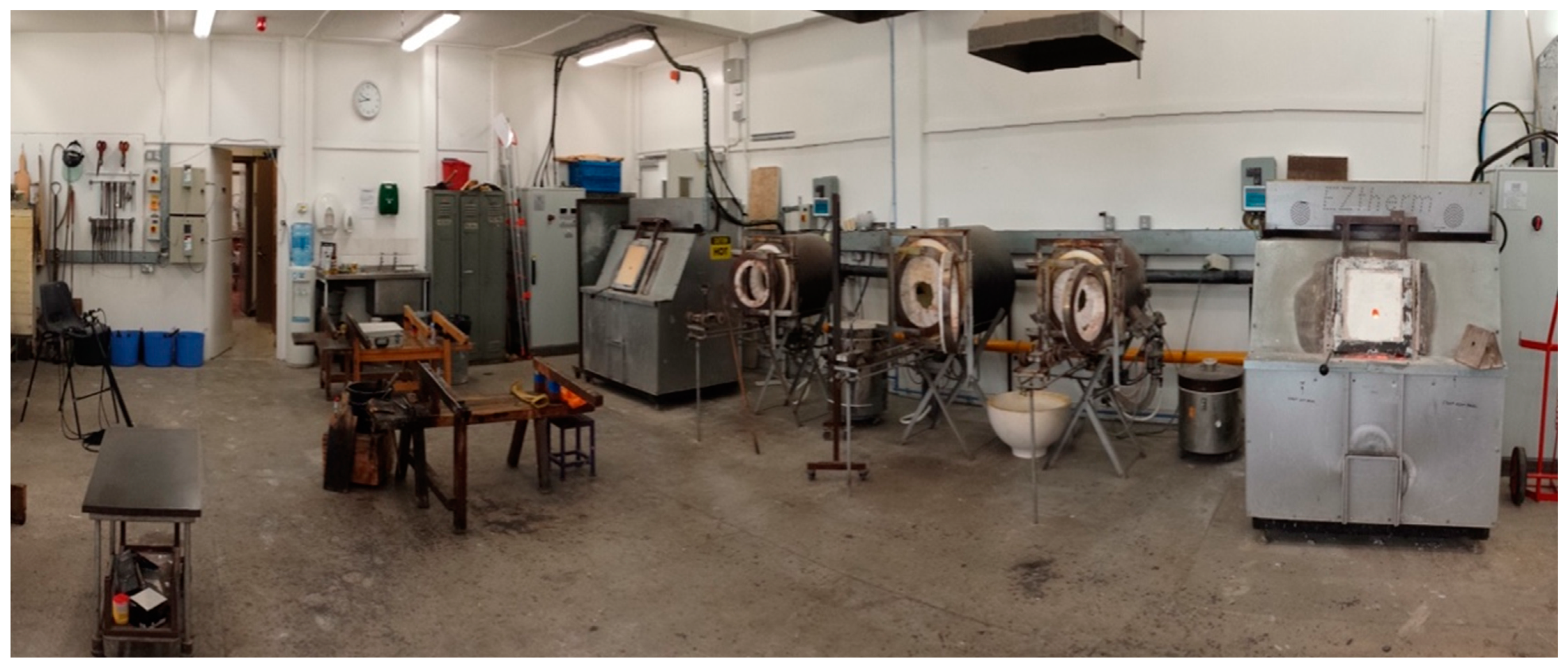
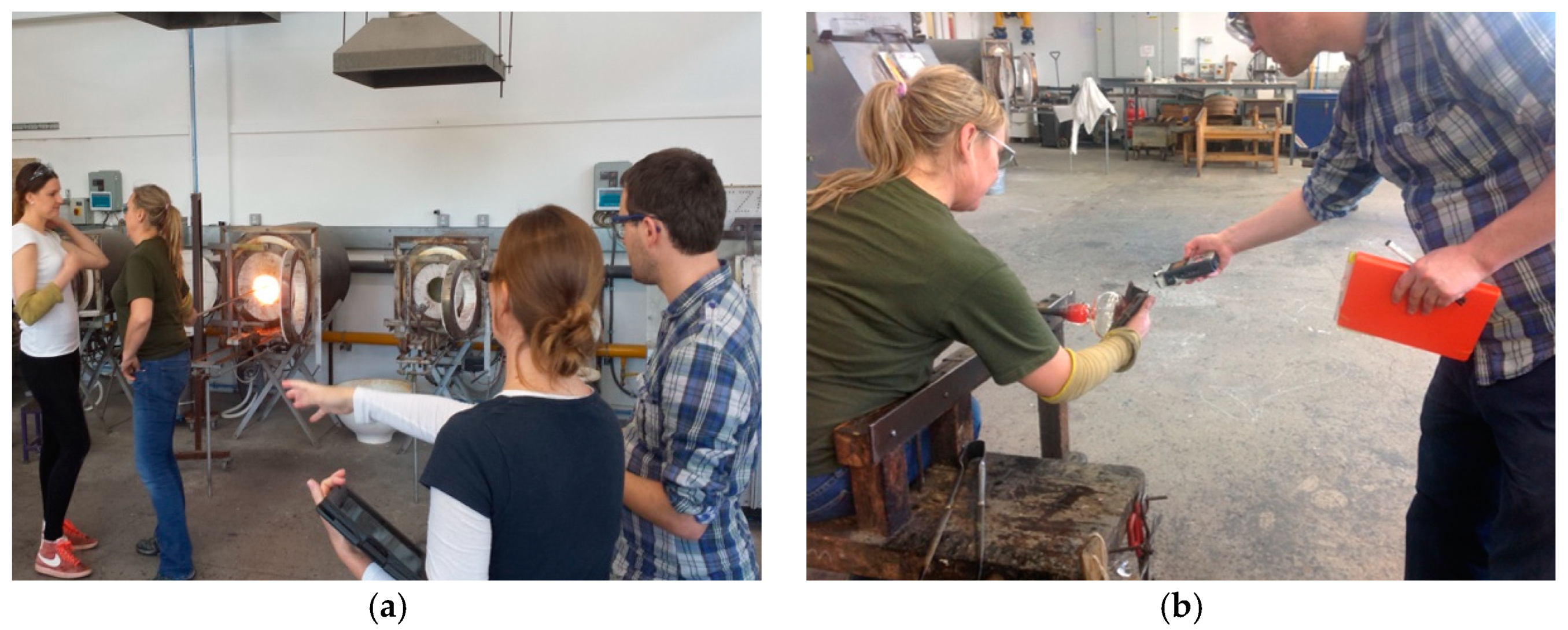
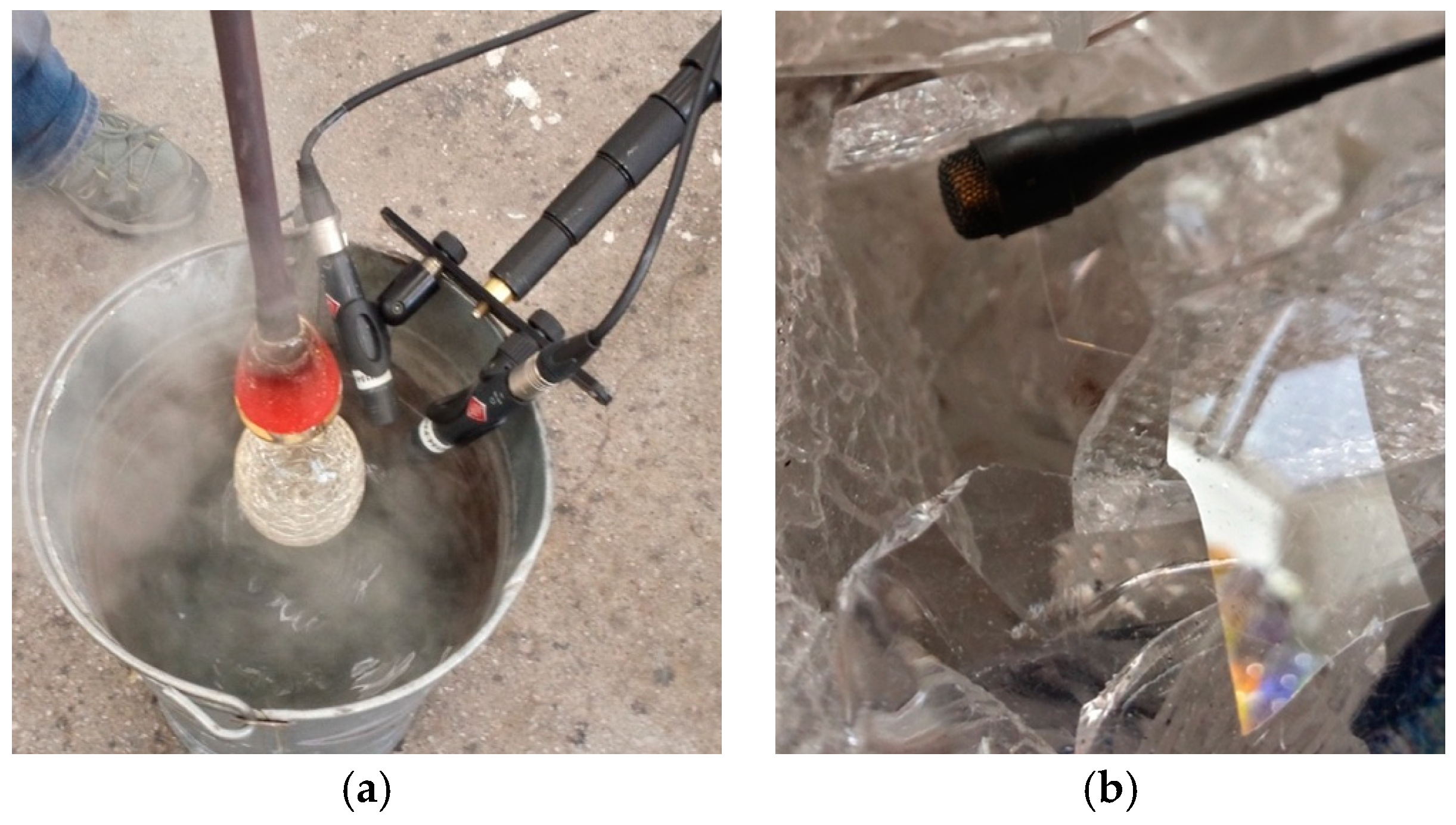
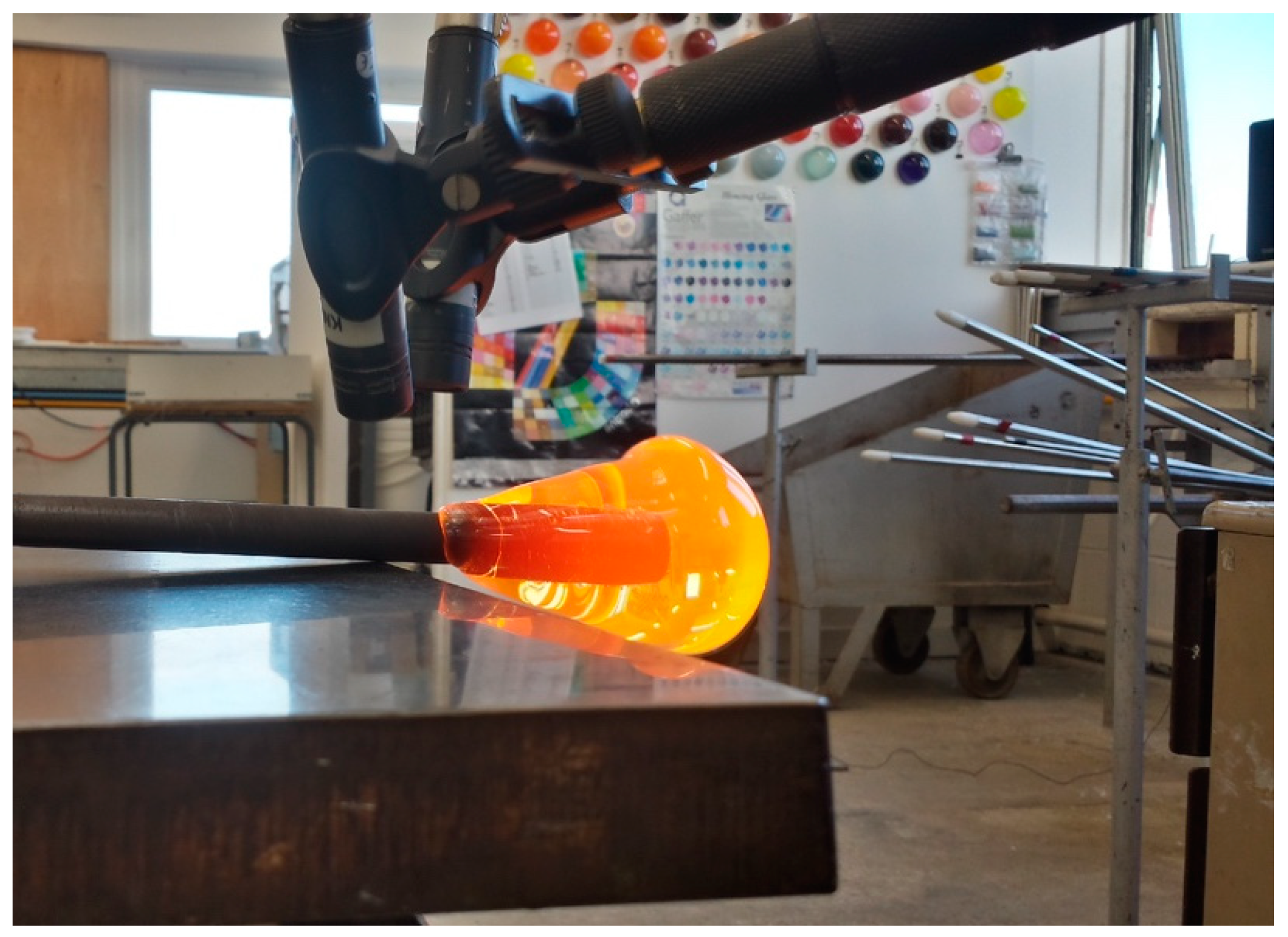
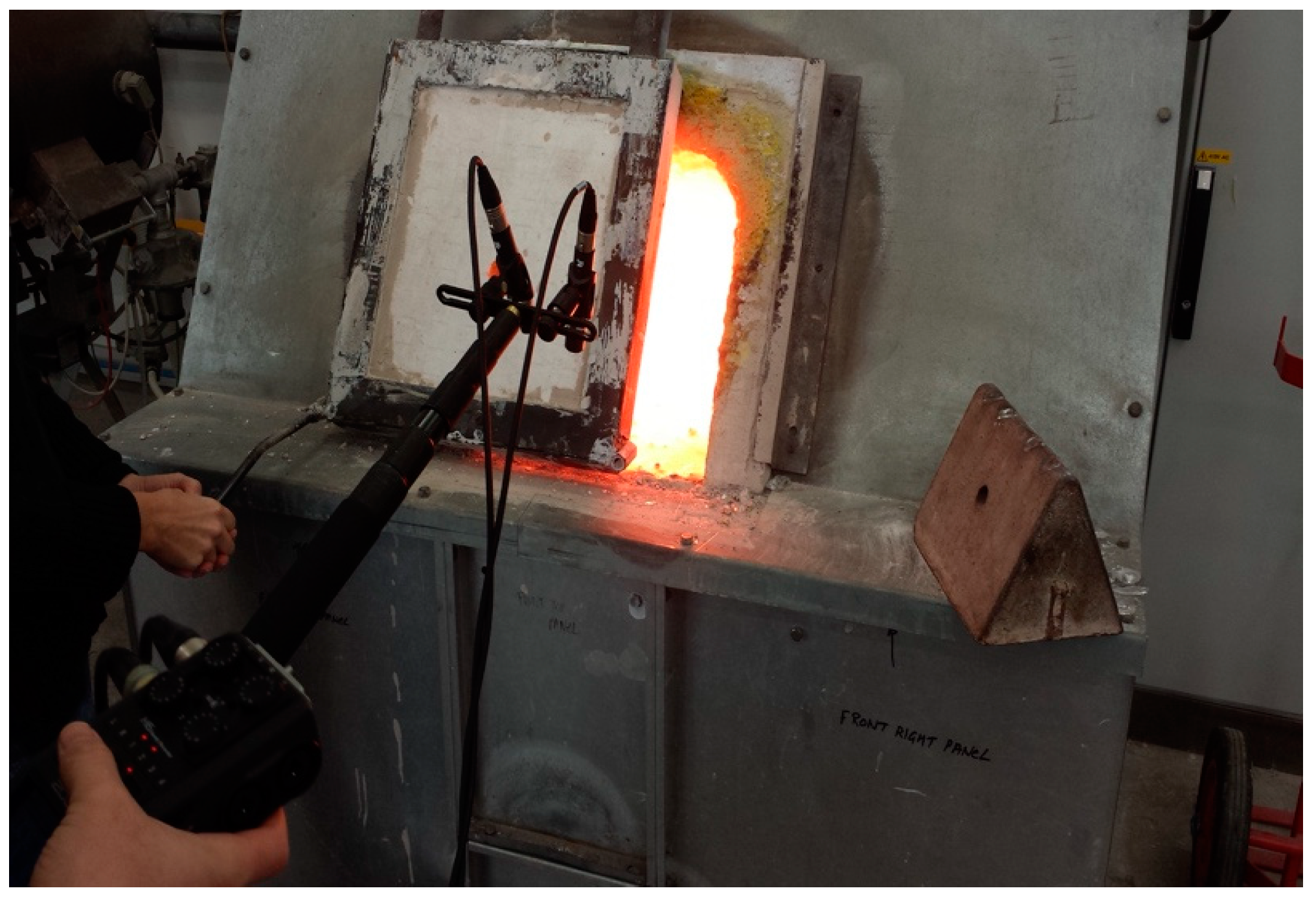
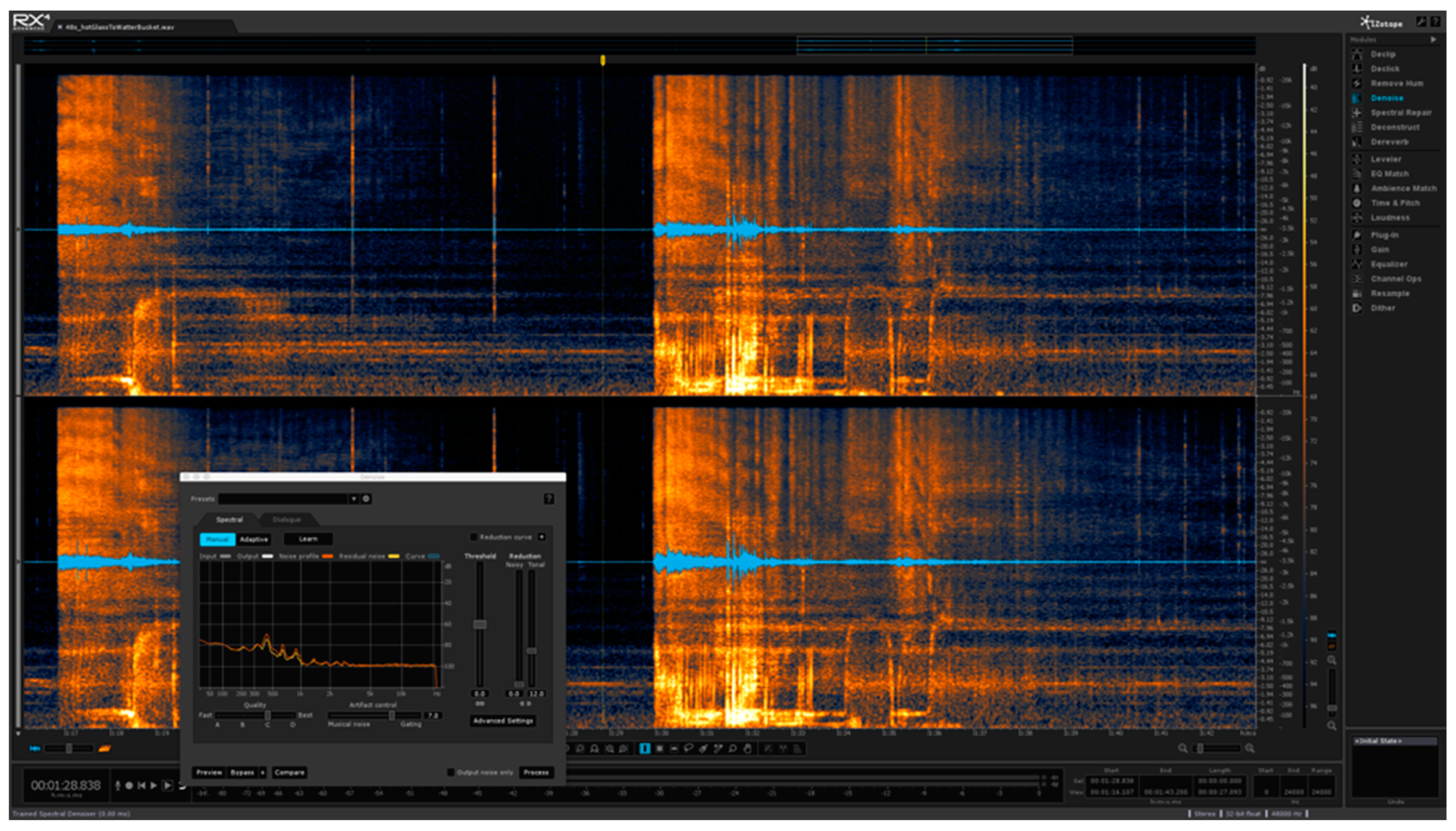
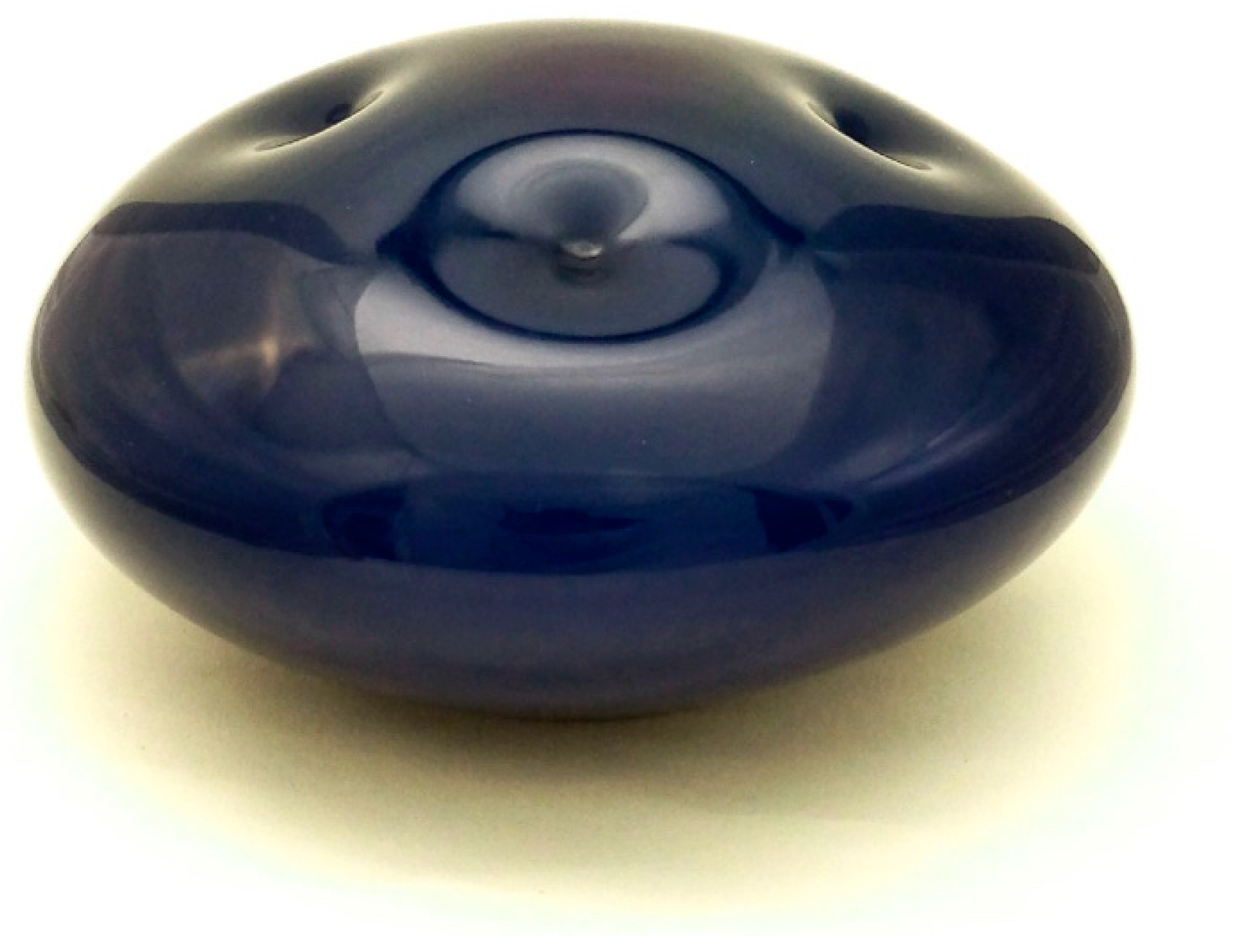
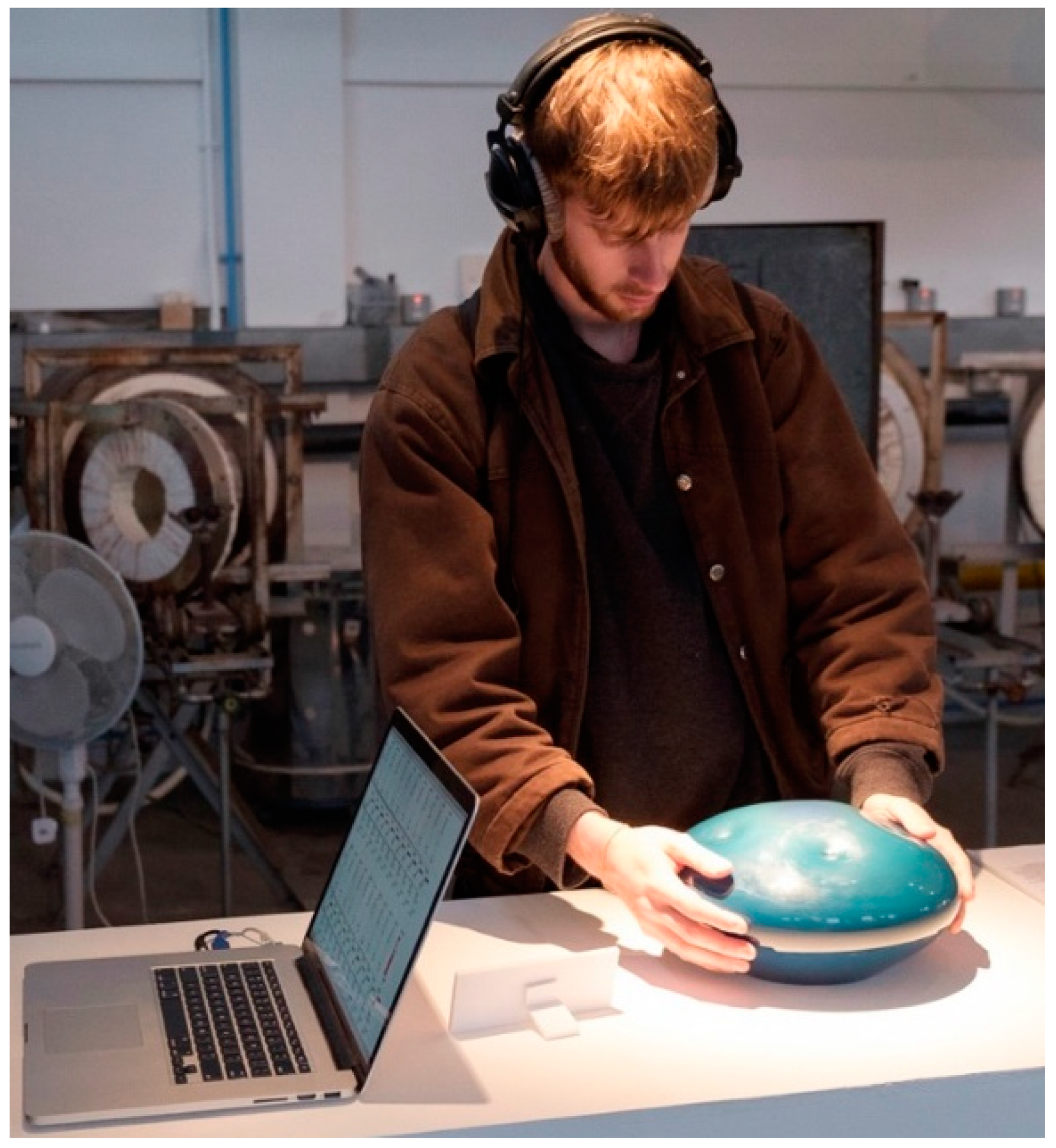
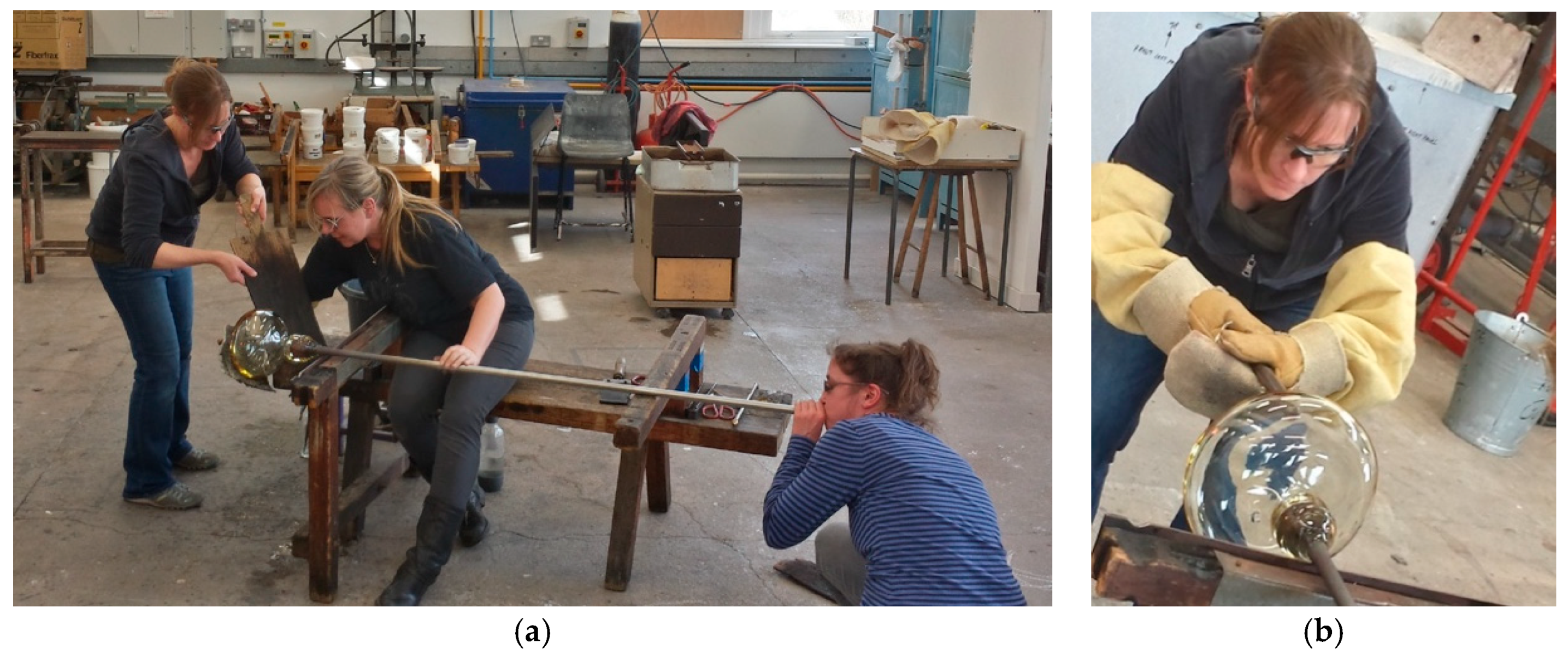
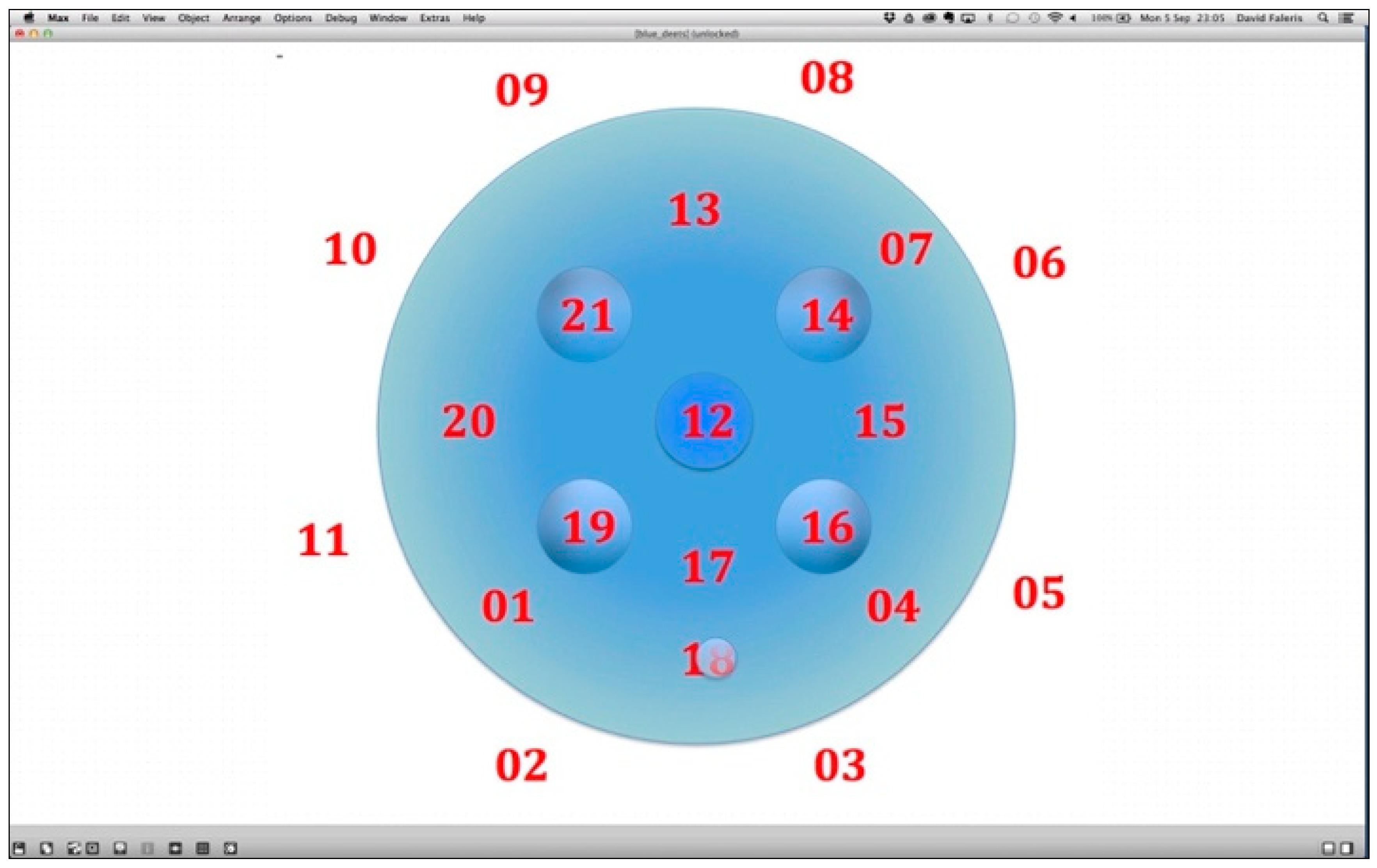
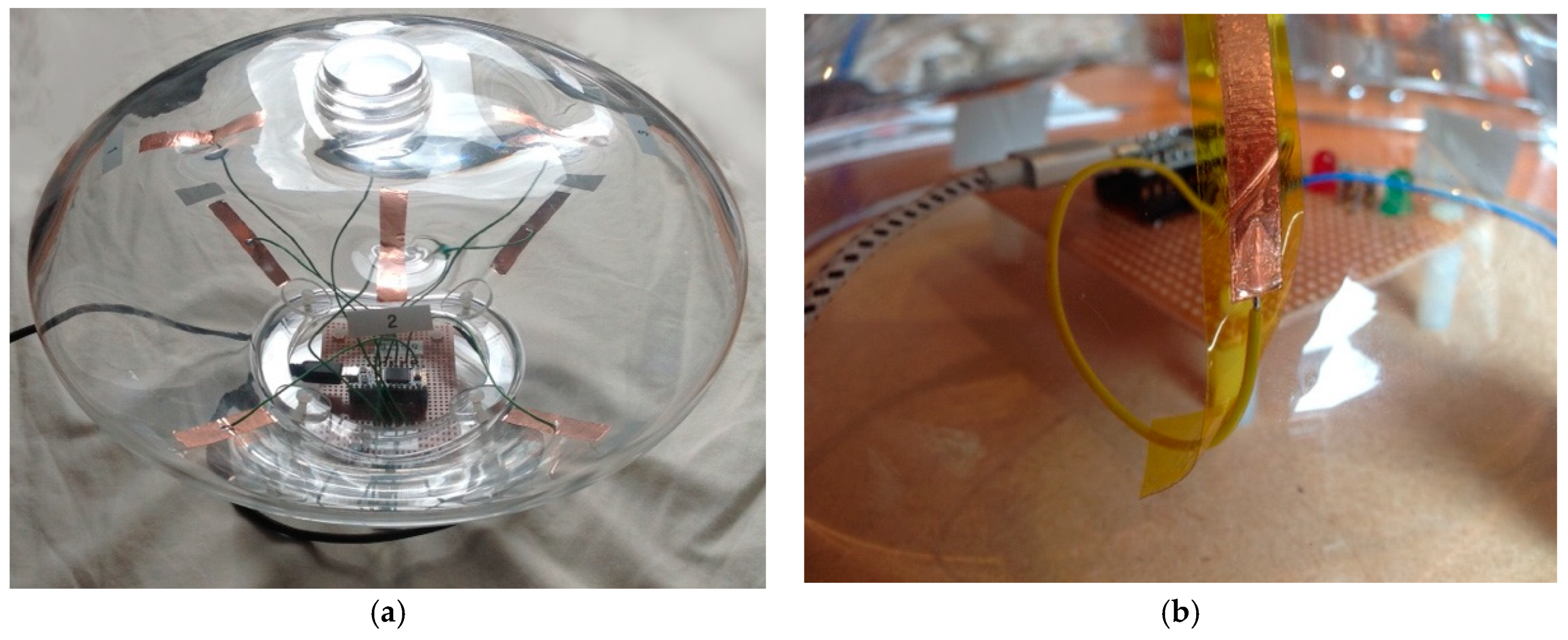
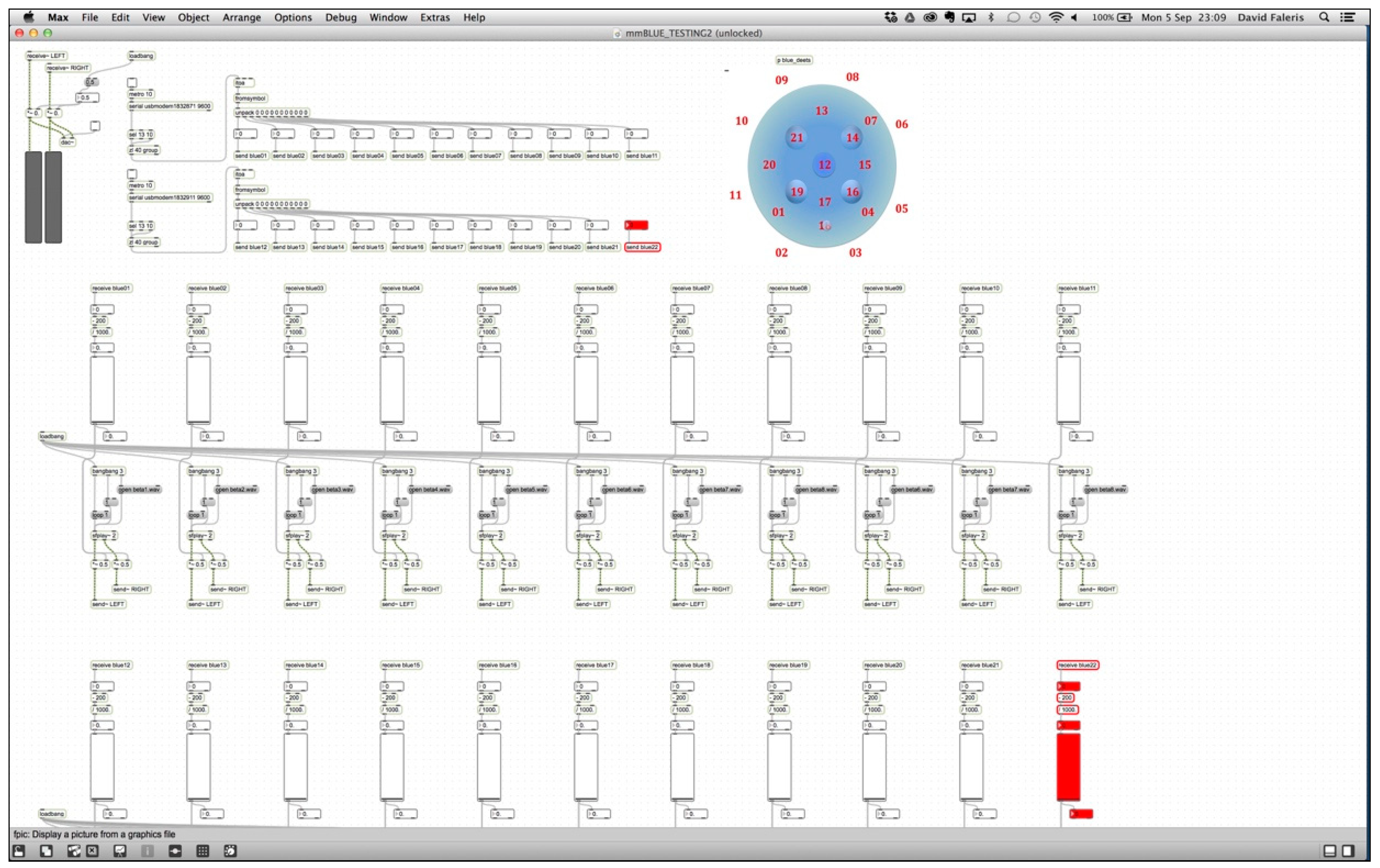
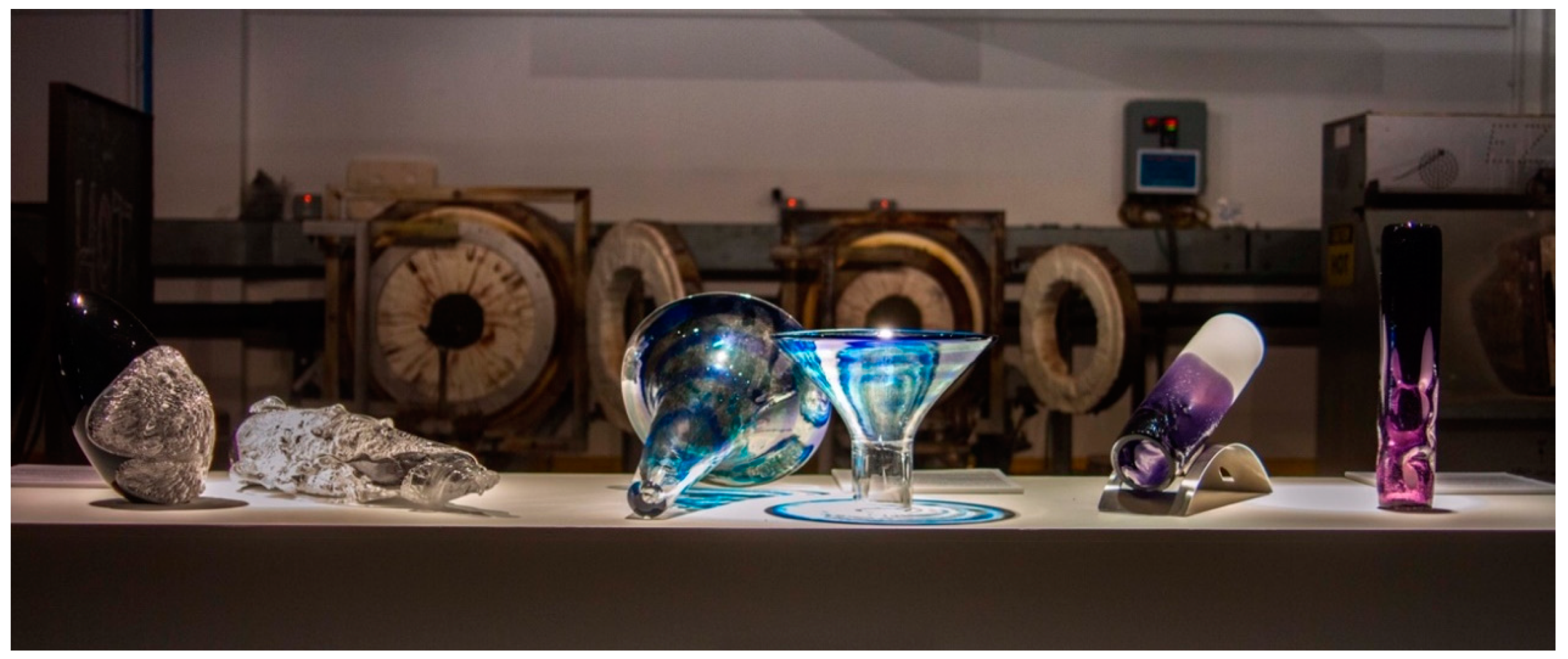
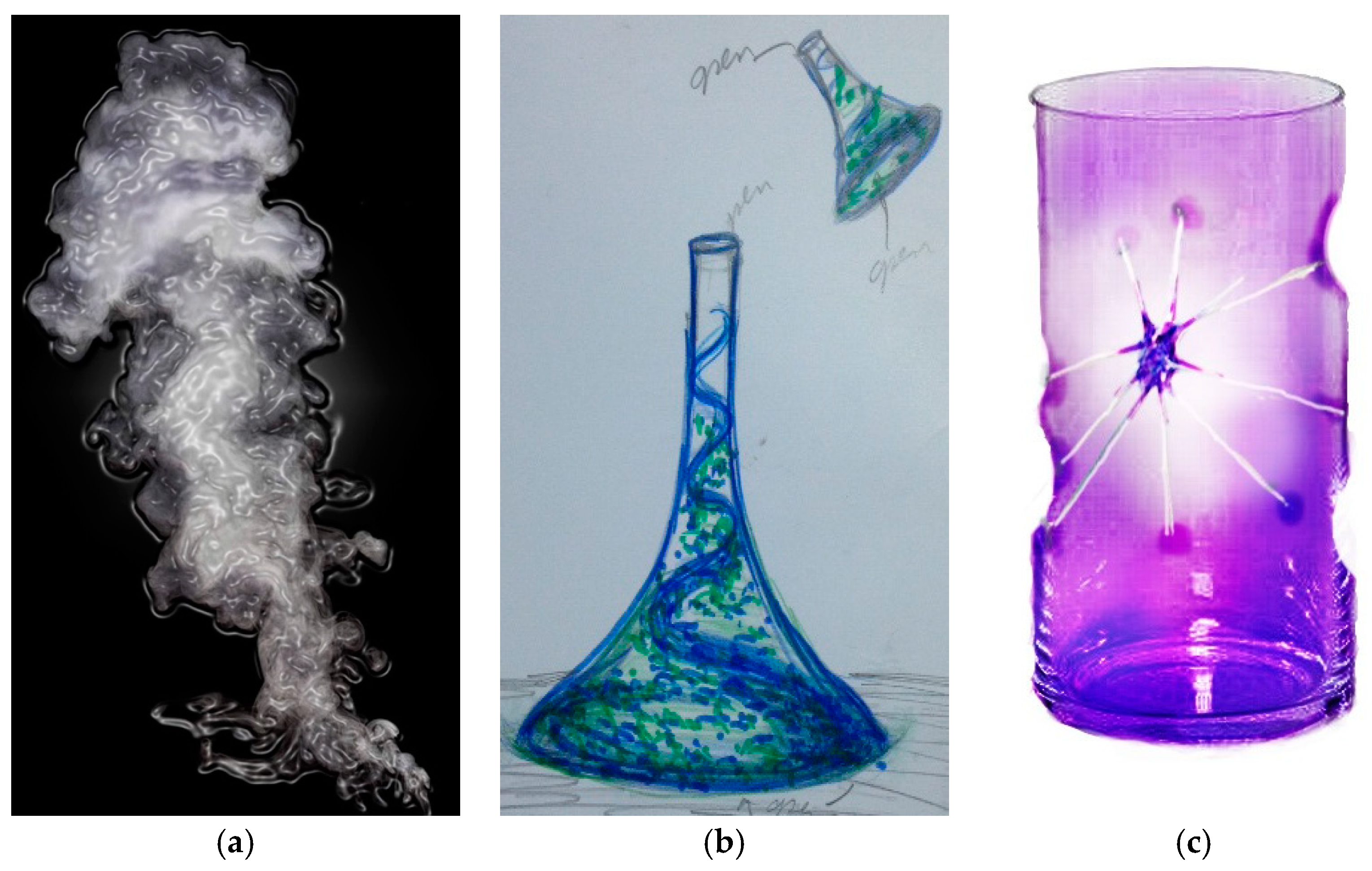
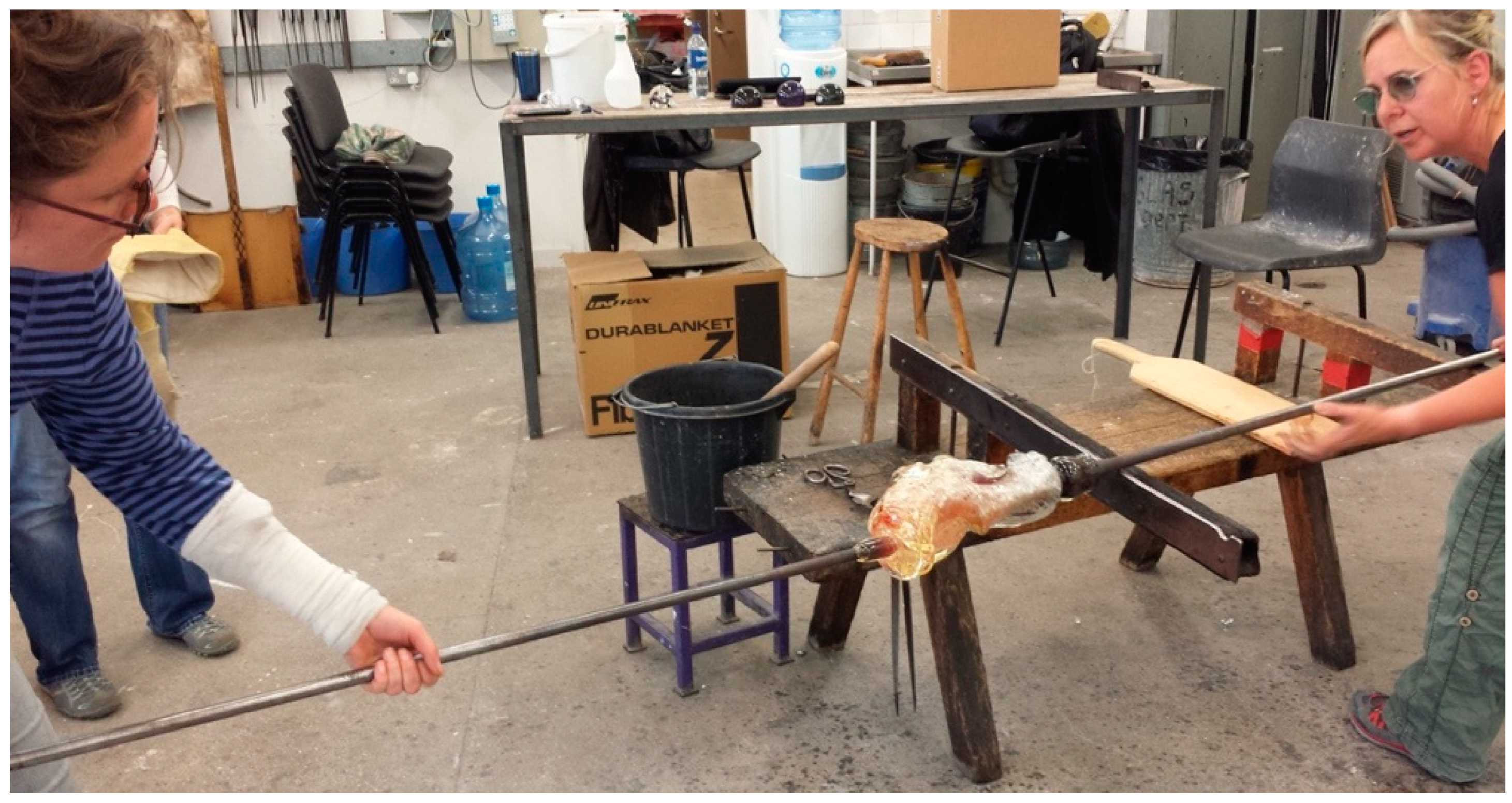
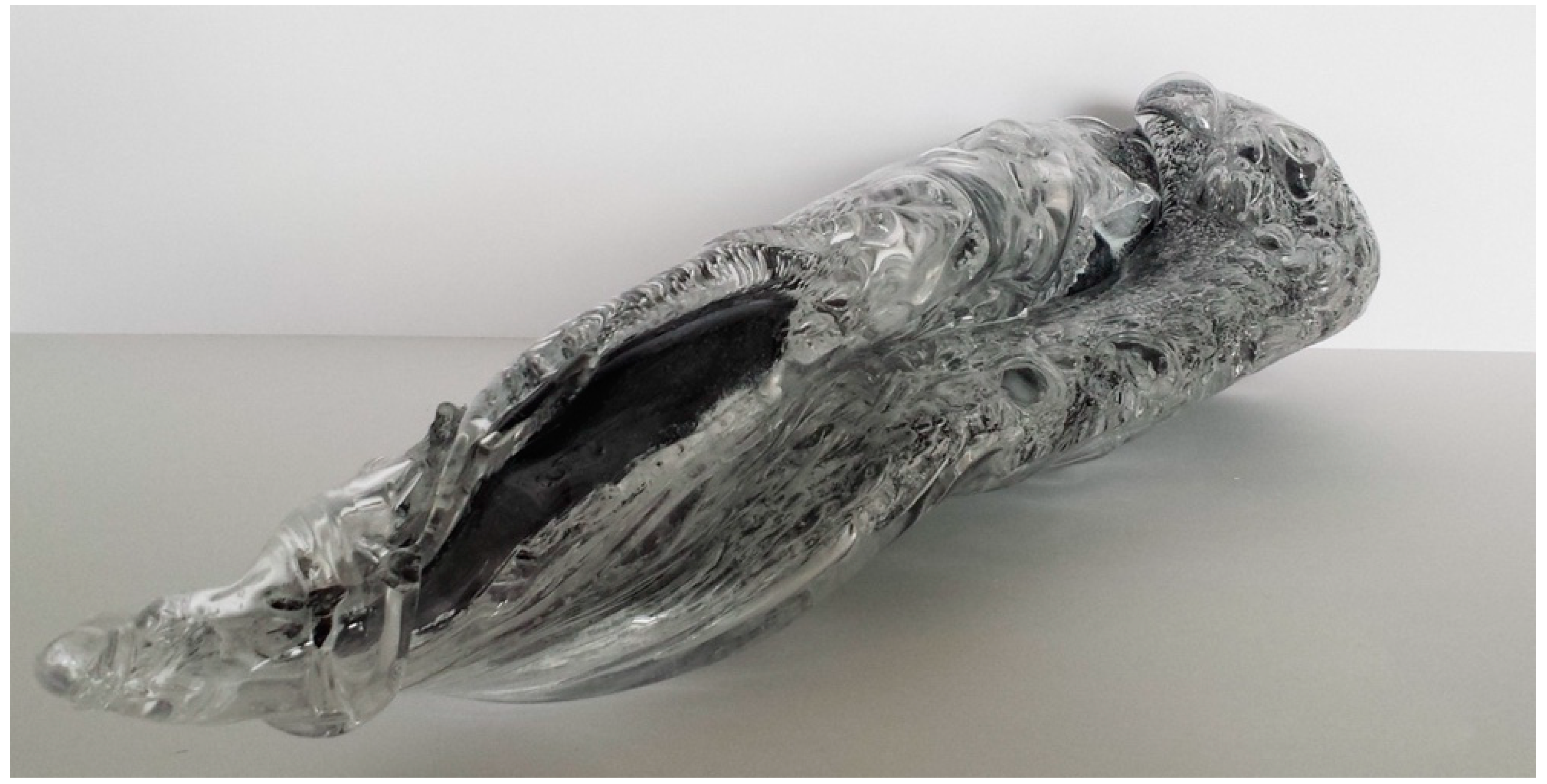
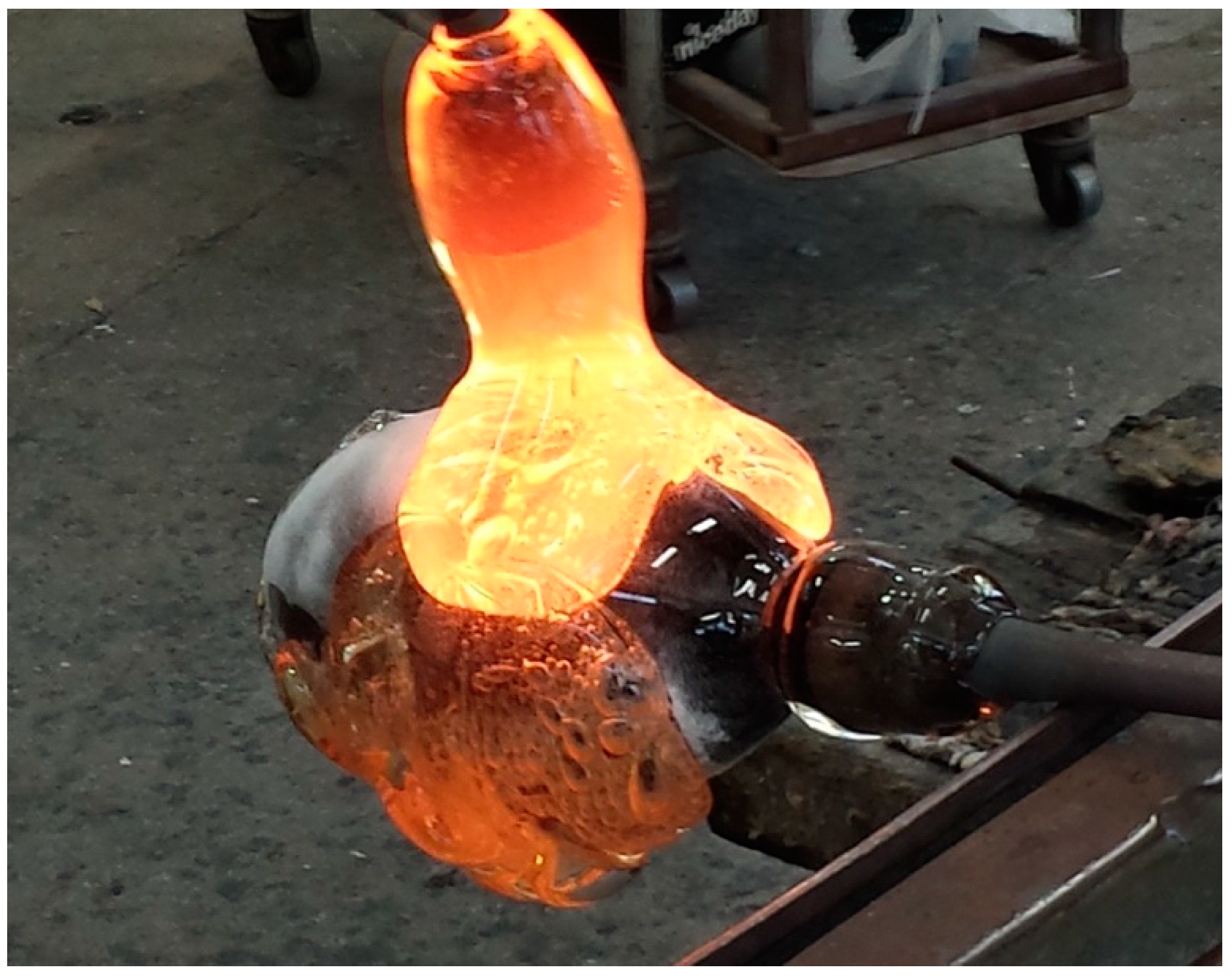
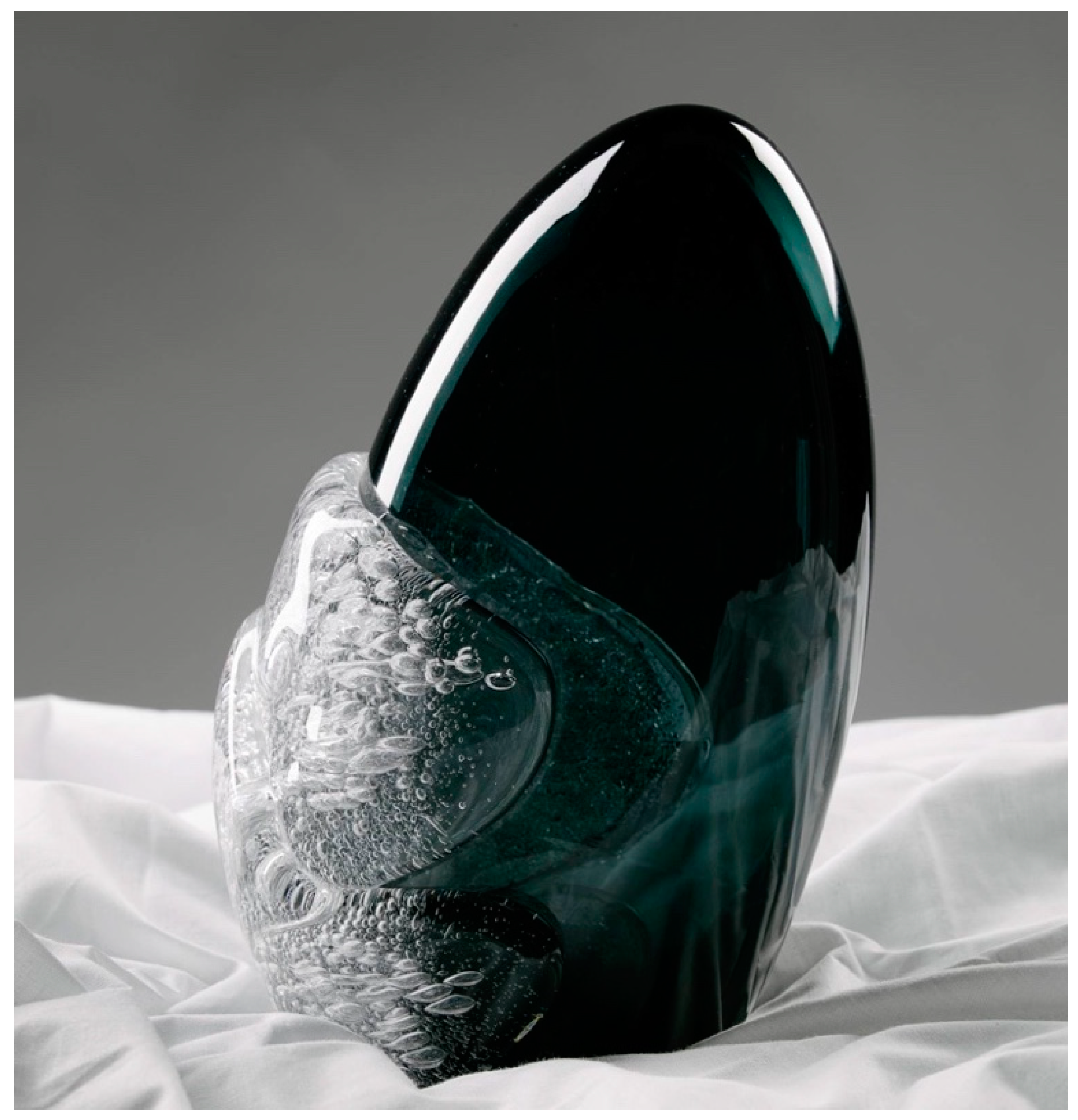
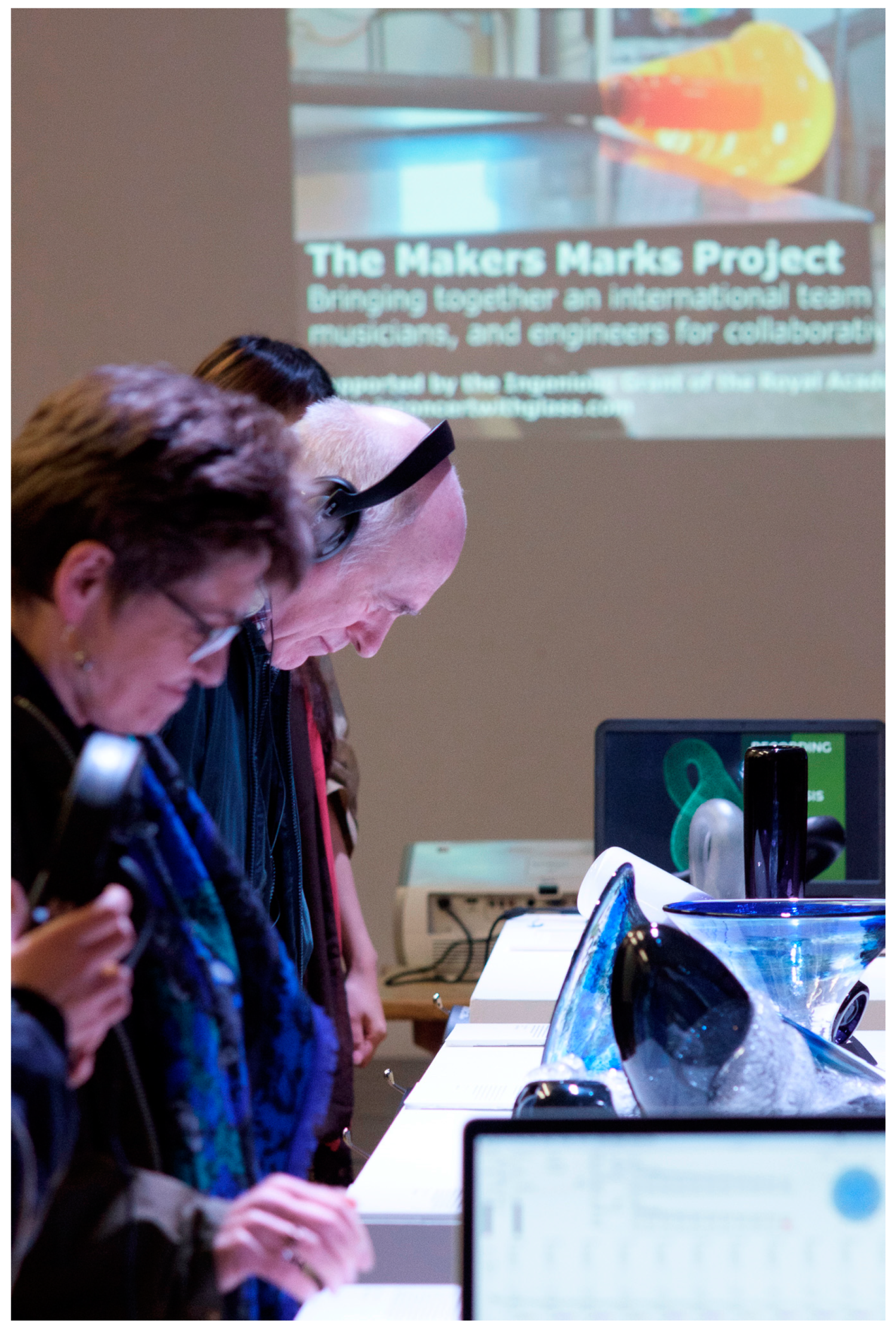
© 2019 by the authors. Licensee MDPI, Basel, Switzerland. This article is an open access article distributed under the terms and conditions of the Creative Commons Attribution (CC BY) license (http://creativecommons.org/licenses/by/4.0/).
Share and Cite
Naas, L.; Faleris, D. Makers Marks: Capturing, Preserving, and Sharing the Sounds of Glassmaking. Arts 2019, 8, 19. https://doi.org/10.3390/arts8010019
Naas L, Faleris D. Makers Marks: Capturing, Preserving, and Sharing the Sounds of Glassmaking. Arts. 2019; 8(1):19. https://doi.org/10.3390/arts8010019
Chicago/Turabian StyleNaas, Lisa, and David Faleris. 2019. "Makers Marks: Capturing, Preserving, and Sharing the Sounds of Glassmaking" Arts 8, no. 1: 19. https://doi.org/10.3390/arts8010019
APA StyleNaas, L., & Faleris, D. (2019). Makers Marks: Capturing, Preserving, and Sharing the Sounds of Glassmaking. Arts, 8(1), 19. https://doi.org/10.3390/arts8010019



